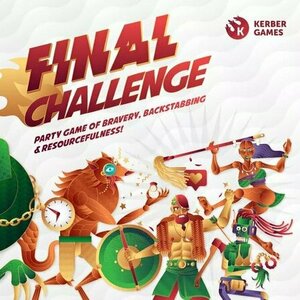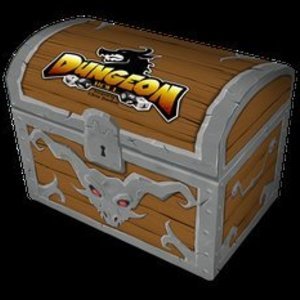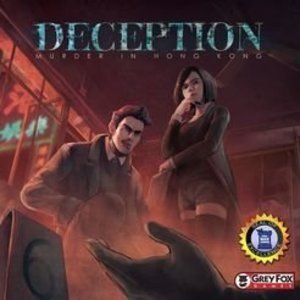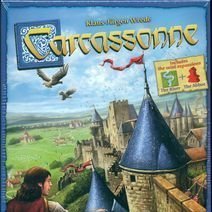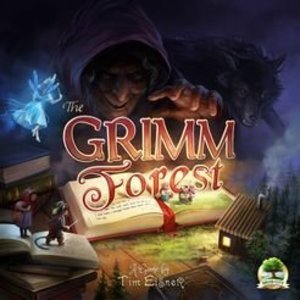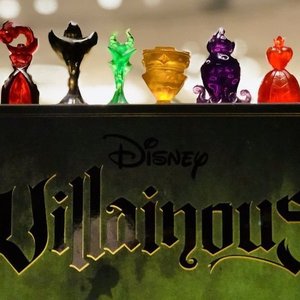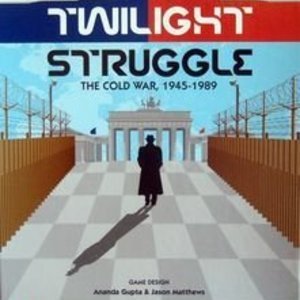
Twilight Struggle
Tabletop Game
"Now the trumpet summons us again, not as a call to bear arms, though arms we need; not as a call to...
Boardgames 2playergames PoliticalGames HistoricalGames
Purple Phoenix Games (2266 KP) rated Final Challenge in Tabletop Games
Oct 1, 2021
Final Challenge is a crazy party game for up to six players. In it, players are attempting to earn cards from different categories in order to place themselves in the Final Challenge round where they will attempt to compete for all the marbles.
DISCLAIMER: We were provided a prototype copy of this game for the purposes of this review. These are preview copy components, and I do not know for sure if the final components will be any different from these shown. Also, it is not my intention to detail every rule in the game, as there are just too many. You are invited to download the rulebook, back the game through the Kickstarter campaign coming October 2021, or through any retailers stocking it after fulfillment. -T
To setup, shuffle all the cards in the game (in this prototype version I was given a smattering of each type of card, including several from planned expansions) and make a large draw pile. Place the timer nearby and give each player a player board and reminder card. Determine the first player and the game may begin!
On a turn, the active player will check their board to see if they have any active challenges. These are challenge cards that have specific timing applied in order to complete. Completed challenges are either placed face-down on their board or discarded. Next, the active player draws the top card from the deck and has three choices: Perform the Challenge, Ask for Volunteers, or Attack Another Player.
The active player will most often prefer to Perform the Challenge by reading the card’s challenge aloud and attempting to satisfy the requirement. Other players at the table are the judges in determining if the attempt is successful or not. If so, the challenge is placed face-down on the player’s board. If unsuccessful, the card is discarded. As this is the only way to progress in the game, it is usually the best bet on a turn.
However, the player may not wish the complete the challenge and can Ask for Volunteers to help perform the challenge. Whomever accepts and completes will win the card and be able to place it in front of themselves for a quick extra boost of completed challenges.
Should the active player not wish to complete the challenge drawn, and to Attack Another Player, they may assign the challenge to another player who already has completed a challenge of the same type previously. This offers some benefit to the assigned player, as they may collect another card of a similar type, and forces them the complete the challenge card instead of the active player. Should the attacked player lose, however, they lose not only the attacking card, but the face-down card they have previously completed!
Once a player has locked (earned completed face-down cards) one challenge card of each type, they have unlocked the Final Challenge. On the back of each challenge card is one word. When placed on the player board the words will spell out a ridiculous prompt that the active player will need to perform in order to win the Final Challenge. In the example photo below, the prompt is: Mischievous Cavegirl Uses Force On Someone’s Ear While Moaning Loudly. Therefore, in order to win this Final Challenge, the active player will need to exemplify this prompt to the satisfaction of the other players/judges. Think about how you would complete this one.
After a successful Final Challenge, the winner collects the red Personality card to add to their winnings. On the backs of red cards are abilities that are now in effect for the rest of the game. The winner is the player who collects two red cards. The rules indicate any stopping point that is agreed upon by the players is acceptable, but they suggest just to two.
Components. Again, this is a prototype copy of this game, and I do not know which, if any, components will be different in the final version. That said, what I received was a box of cards, player boards, reminder cards, and a sand timer. Also included were card dividers, which confused me since the cards are to be shuffled for play. I like the direction the game is going, especially with regards to aesthetics. In a crazy over-saturated niche of party games, Final Challenge is trying to be a little different. The art is quirky, and that is definitely not a bad thing here. All the text is easily legible and the sand timer… works. It is fine as is, but I am sure that a successful Kickstarter will improve all the components in the game.
I am definitely not a party game kind of guy. My wife always makes fun of me when I groan at them, like I am some board game snob. And maybe I guess I really am. I know how I would like to spend my gaming time, and usually it is not with a party game. That said, Final Challenge does offer something a little different by having each card present a challenge that could be storytelling, actions, impersonations, and all kinds of cuckoo… but I like it. Now, I think every game has its place, and for me and my typical game groups, this would be a great one to pull out when I introduce fresh gamers into the hobby, or as something to completely break the ice/tension. As long as all players understand that they may need to get out of their comfort zones to have a good time with it, Final Challenge can be that entry into the hobby for some.
My highest-rated party game to this point is Happy Salmon, and I use it for silliness between heavier games, or to help re-energize my players. It works wonders, and I love it for that. I don’t think Final Challenge will replace Happy Salmon for me for its purpose, but I definitely can see instances when I would need something with just a little more meat on its bones, but still in the ridiculous category. So if you are in need of a weird, quick, zany, little card game (with origins in Serbia – how many Serbian games do you have?) then check out Final Challenge, coming to Kickstarter in October.
For those more raunchy gamers, I have some insight for you as well. I said earlier that Kerber was kind enough to pepper this copy with a few cards from expansions as well, and one of them is the “Rated R Expansion.” I won’t give you exact examples of cards from that set, but just as a levels-check, two cards I pulled from the normal deck has this text on the front, “You have ended up in a talent show. Tell a joke. If no one laughs, you lose.” On the back of this it says, “Their Nipples.” Another example from the core set is, “Someone in this group just got immensely attractive. Point that person out by casually looking at them in a seductive manner until your next draw.” On the back? It says, “While Praying.” Soooooooo, the fronts and backs don’t necessarily have anything to do with each other… but they could. Enjoy the game, everyone!
Purple Phoenix Games (2266 KP) rated Dungeon Roll in Tabletop Games
Jun 12, 2019
Dungeon Roll is a quick and fun dice-rolling game where Heroes delve into a dungeon to fight monsters (potentially including a dragon!), find treasure, and gain experience points based on how deep into the dungeon they go. If you are playing in a group or solo, the rules of the game are the same – the only difference is how you win! In group play, the winner is the player with the most experience points after 3 rounds of play. In solo play, you are working to get as many experience points as possible – competing against previous plays trying to best yourself!
After a few runs of Dungeon Roll, it has quickly become one of my favorite games to play solo for two main reasons. First, I like and appreciate the simplicity of the rules. It is quick and easy to learn, and the solo variation has no extra rules or stipulations. Simply put, I don’t have to worry about forgetting solo rules because there aren’t any! Don’t have any other players? Great! Just play like you normally would! Yeah, I may have to roll my own Dungeon Dice, but I don’t have to worry about controlling any ghost players or remembering whether or not I need to start the game with a solo handicap. The simplicity and uniformity of the rules, regardless of player count, means that I don’t have to spend time re-reading the rulebook to refresh my memory on solo play, and can just get down to playing instead!
The next reason why I love to play Dungeon Roll solo is due to the variability and unpredictability of the game. The base game comes with 8 Hero cards, each with unique abilities, and the expansion packs provide even more Hero choices. Different heroes/abilities lend themselves to different strategies for success – there is not one right way to play. Even if you pick to play as the same Hero every game, though, the dice rolling mechanism makes sure that no two games are ever alike. Dice rolling can be a fickle friend, and oftentimes the success (or failure) of a round depends solely on the luck of the roll. I, unfortunately, am a notoriously bad dice-roller…. BUT that helps make this game more interesting for me because it forces me to really strategize how I am going to use my Hero abilities, treasure tokens, and dice to my benefit. Sometimes it works out well and I come out with a respectable score! But then again, sometimes it’s the exact opposite and I come out wondering whether or not I should even log the play with as feeble a score as I got… Either way, dice rolling is unpredictable and that (along with different Hero abilities and treasure tokens) makes for a unique game every time.
Dungeon Roll is a fun and competitive game for both groups and the solo player. This game is deceptively simple and wildly entertaining, and I highly recommend adding it to your solo arsenal!
https://purplephoenixgames.wordpress.com/2018/12/21/solo-chronicles-dungeon-roll/
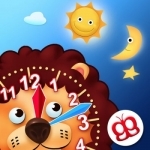
Interactive Telling Time Pro
Education and Games
App
- Selected by Apple as iPhone App of the Week in Germany, Switzerland, Austria, Overall New &...
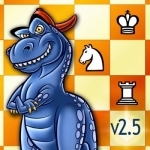
Dinosaur Chess: Learn to Play!
Education and Games
App
** Appysmarts.com: 97/100 EDITOR'S FAVORITE! ** Previously nominated for a BAFTA (Best Interactive...
Purple Phoenix Games (2266 KP) rated Deception: Murder in Hong Kong in Tabletop Games
Jun 12, 2019
MURDER! As an Investigator, that’s just another day on the job for you. This time feels different, though. Something about this case is off… After the initial evidence is gathered, the team’s Forensic Scientist has disclosed to the team that the killer is one of the Investigators! Everyone is on edge, accusing every other Investigator of being the murderer. Everyone had potential means and motive, and it is up to you to figure it out! As the Forensic Scientist uncovers more evidence, the details of the crime will come to light, and the killer will be revealed. Put your investigative and deductive skills to the test as you try to unmask the killer, or throw the team off your scent if you are the culprit!
DISCLAIMER!! This review is for vanilla Deception: Murder in Hong Kong. We have plans to add in the expansion once one of us purchases it and learns it and teaches it to the rest of us. Should that happen and our review change, we will add that information to this review or to a new review and link to it from here. -T
Deception: Murder in Hong Kong is a game of bluffing, deduction, and hidden identity. All players (except for the Forensic Scientist) have a secret role in the game – Investigator, Witness, Murderer, or Accomplice. The Forensic Scientist knows who the killer is, and how they did it. It is their job to guide the Investigators to the killer by providing clues about the uncovered evidence. The Investigators are trying to interpret the clues and uncover the killer’s identity. The Witness knows who the killer is, but has not yet figured out how they did it. The Murderer and Accomplice are looking to pin the murder on one of the other innocent members of the team! As clues are revealed, each player gets a chance to make a case against the player whom they think is the murderer. You must convince everyone of your logic, or else the killer could get away! In a game where everyone is a suspect, who can you trust? Gather clues, present your case, and put your poker face to the test in this ultimate game of deception! (See what I did there?)
I thoroughly enjoy games of deduction. Anything where you have to think and solve puzzles/riddles/etc. is fun for me. In Deception, it’s a race to see who can find the solution first. Not only do you have to deduce the correct answer from the provided clues, but you also have to put your persuasive skills to the test! Unless you can convince everyone that a specific player is the killer, they might turn their accusations towards someone else, or even worse, towards YOU! You really have to think outside of the box to interpret the Forensic Scientist’s clues, and I like to challenge myself to find the solution in as few turns as possible. The faster I can solve the murder, the smarter I feel. Don’t lie, it makes you feel smart too when you figure it out before anyone else!
The only part of Deception that I don’t really enjoy is the bluffing aspect, which is one of the most integral parts of the game, I know. I am just a horrible liar with a questionable poker face. If we play and I am the Murderer, I am almost always found out. Whenever anyone accuses me, my mind blanks and I cannot think of a single convincing way to get everyone off my scent! That is a personal problem, though, because when I get to be just a regular ol’ Investigator, I have a blast! I can still be accused, but I always feel like I have an easier time getting people off my case if I am actually innocent. I know some people really enjoy being the Murderer because they like the challenge of deceiving the entire team. I am not one of those people though. If I was guaranteed to be just a plain Investigator (or the Forensic Scientist) every time, I would probably pull this game out more!
Deception: Murder in Hong Kong is a ‘party’ game, but with the right group, it can still be a challenging game. A higher player count, in this case, does not necessarily equate to a chaotic game either. So give Deception a try. It’ll be worth it! Purple Phoenix Games gives it a 17 / 24.
https://purplephoenixgames.wordpress.com/2018/12/26/deception-murder-in-hong-kong-review/
Rikki Hammond (33 KP) rated Carcassonne in Tabletop Games
May 23, 2019
The rules of Carcassonne are very simple. Each player will pick a random tile from a stack, and starting with the first player (who always starts with the same beginning tile) will place their tile, so that it connects to one or more adjacent tiles. Each tile will have a road, city or church on it. Roads can only connect with roads, cities with cities, and churches around either of these.
Once a tile is placed, the player can then choose to place one of their meeples on it, either on a road, city, church, or surrounding field. Once that particular area is completed (a road connects to a town, city or church on either end or a city is completely walled around) then that meeple scores you points. 1 point for each section of road per tile, 2 points for each city piece per tile (double if that city tile has a shield on it) and you will score 9 points if you manage to completely surround a church with 8 other tiles. Once the meeple scores, the player removes it from the tile, and can be used again on another tile.
Play continues like this until the tile stack is depleted, then some endgame scoring occurs, where unfinished roads, churches and cities score 1 point per tile in the area. If farmers were used (laying a meeple face down on a field) then 3 points are scored per completed city in that field area. If ever two meeples share the same city, road or field through future tile placements, then each player will get the same points, and whoever has the most points at the end, is the winner.
Carcassone plays between 2 to 5 players, and having played with all player counts, I can say that it plays well, no matter how many players are there. The components are great. The tiles are colourful, and one the game is over, you can build some pretty impressive landscapes. Each player will have different coloured meeples, so it's easy to tell whose is whose, and the score tracker is a handy addition.
My only criticisms I can find is that, after playing a few games, you find that there's not much in the way of variety when it comes to placement of the tiles, and some more hardcore gamers could class this game as too simple. But these are very minor niggles.
Personally, I think Carcassonne is a fantastic first step for people who may not have played many board or tile games before, and if you do get tired if it, there are tonnes of expansions for it, which can add more variety to the game.

Unblock Me Premium - Classic Block Puzzle Game
Games and Entertainment
App
Unblock Me have more than 120 Million Downloads! Featured in the App Store's "What's Hot" list...
Purple Phoenix Games (2266 KP) rated The Grimm Forest in Tabletop Games
Apr 9, 2021
The Grimm Forest is a simultaneous action selection, set collection, take that game for four family members of the infamous Three Little Pigs. As fantasy contractors players are tasked with constructing three houses as sturdy and quickly as they can. However, these contractors will have competition for limited resources, as well as the occasional interference from scary creatures and buddies of opponents. Like the baseball movie says, “If you build it, you will win the contract to build more stuff.” Or something like that.
DISCLAIMER: We were provided a copy of this game for the purposes of this review. This is a retail copy of the game, so what you see in these photos is exactly what would be received in your box. I do not intend to cover every single rule included in the rulebook, but will describe the overall game flow and major rule set so that our readers may get a sense of how the game plays. For more in depth rules, you may purchase a copy online or from your FLGS. -T
To setup, place the Location boards on the table for the Fields, Forest, and Brickyard (for a three-player game, as below). The First Builder Bonus tokens are placed below the matching Locations as well as the resources that can be harvested. One of each Mega Resource (5 Straw, 4 Wood, 3 Brick) are placed on the matching Location at the beginning of each round. The Friend and Fable decks are shuffled and placed nearby, as are the House sections (Floors, Walls, Roofs – Rooves?), and the Monster minis. Each player chooses a color and collects the Player board, Pig mini, and Gather cards matching that color. The first player is given the Starting Player tome token and the game may now begin!
The Grimm Forest is played over a series of rounds with each pig having a multi-step turn. Initially, however, the pigs will be deciding from which Location they would like to harvest resources by laying the corresponding Gather card from their hand to the table face-down. Once all pigs have laid their card, the Gather cards are flipped and revealed simultaneously. If any pig had chosen to also play one Fable card it would have been revealed and possibly resolved prior to this step. Players will place their Pig mini on the Location board they chose and then harvesting of resources may begin, unless a player has a Fable card that resolves at this point in the turn. If a Pig is alone in a Location they receive all resources currently found there. If Pigs share a Location then the shared minis will share the resources equally, keeping any remaining resources on the Location for the next round. If any player used a Fable card that activates at the end of the Gather phase, it is resolved now.
After the Gather phase, the Pigs will be able to take actions. On their turn, in turn order, each Pig may choose to perform two of the following actions in any order they wish (actions may be repeated except for Friend Special Actions): Draw a Fable card, Gain 1 Resource, Build, Special Actions. Drawing a Fable card is self-explanatory and players will keep their Fable cards secret from the other players. They may choose to play one of these Fable cards during the choosing of Gather cards portion of the beginning phase of a turn. A Pig may instead wish to gain one resource of their choosing and add it to their collection. As mentioned earlier, a Pig may also use their active Friend card’s (which is earned by building a Wall section) Special Action once per turn, should they have collected one earlier.
The true hero of The Grimm Forest is the Build action as this is what propels players to victory. Pigs may Build any house type they wish, as long as that type is not currently under construction elsewhere on their board. Also note that houses must be built from the ground up so Floors must be present before Walls can be built and Walls need to be constructed in order to hold up a Roof. Pigs may build these sections of houses by discarding the appropriate number and type of resources they have gathered previously: two resources for a Floor, four resources for Walls, and six resources for a Roof. Once a Pig completes construction of the first house of a type they will grab the matching First Builder Bonus token and reap its rewards.
The game continues in this fashion until one player has built three houses of any type, or multiple players have completed their three houses by the end of the round. Those tied players then check for sturdiness to break their tie: brick houses are sturdier than wood, which are sturdier than straw. The winner is the player with the sturdiest collection of houses, and then all players are invited to share a plate of bacon in celebration of the win (not in the rules, but I added that for… flavor).
Components. This game is chocked full of killer components. I do not oftentimes compliment boxes and inserts, but when a game comes with GameTrayz already, you know that the publisher cared a ton about the game. Everything sets up and tears down so much nicer and quicker with a GameTrayz insert that I wish every game would come with them. Yeah, I know, $$$. Outside of the insert (or inside?) the other components in the game are simply stellar. Everything from the card backs resembling book covers, the incredible plastic house pieces, and amazing minis, just makes this one sing when on the table. The art is done by the incredible Mr. Cuddington, and they are quickly becoming some of my favorite board game artists.
Wait, there are monster minis? But I didn’t talk about that in my overview. Well, yes, that’s correct. These monsters come into play from certain Fable cards, and when they are played it instructs the player to introduce the appropriate monster mini on the playing area. This can be done with such dramatic flair that you truly get a sense of dread that little piggies may feel. If you have seen Stranger Things (not a sponsor) and remember the part when the Demogorgon mini hits the table, then you understand how I introduce my monster minis. These monsters wreak havoc on the players and sometimes deny them resources, and other chaos to mess with pigs.
Overall, I am so enamored with this game. It has nearly everything I love about games. It has amazing theme and art. That is always big with me. The components are super high quality, as all Druid City Games/Skybound Games usually are, and the game is so smooth once it is learned. All phases and turn components work together well, and there are plenty of choices each player makes every round. The game comes with advanced rules and components as well once all players are comfortable with the base game, and I love when games come with that added complexity and difficulty.
I have nothing bad to say about this game at all, which makes me sad, because I can usually find something to improve with every game I play. Okay wait, I just thought of one: I appreciate that the player colors include both orange and purple, but then the others are blue and green. I think the player colors could have come with some different choices as I feel blue, green, and purple are within similar color bands. Maybe pink and aqua would be better choices for my taste? I don’t know, and I am sure research was done to decide on the player colors, but like I said, I needed to find SOMETHING to complain about.
So it is certainly no surprise that I love this game and rated so highly. I doubt it will ever truly break into my Top 10, but I feel it ticks all of my boxes for a great game and a 6 from me. Purple Phoenix Games as a whole gives this one a porky 15 / 18. If you are looking for a great game that is admittedly lighter, but gives great gameplay throughout, features incredible art and components, and offers opportunities for role-play then you definitely need to grab a copy of The Grimm Forest. I will be recommending this to so many gamers in the future, and I will be pushing the floor of the age suggestion on the box once my son decides he wants to learn to read. I think I am going to go try out the Advanced rules now, and remember: don’t eat an apple that a scary person gave you at the door.
Purple Phoenix Games (2266 KP) rated Disney Villainous in Tabletop Games
Jan 6, 2020
Disney Villainous (“Villainous” from here on) is a card game that pits players against each other in a race to complete individualized objectives to win the game. Players are in direct competition with each other and have devices to employ to spoil the plans of their competitors. Can Maleficent place out curses on all the lands in her realm before Hades can have three Titans storm on Mount Olympus? Can Prince John attain 20 power before either of them win the game? Such is Villainous.
DISCLAIMER: This game has a few standalone expansions now, with more on the way I’m sure. We are using components from the base game as well as the first expansion, “Wicked to the Core,” for this review. Should we decide to review the expansions as standalone games, we will link to the new material here. Furthermore, I do not intend to cover every single rule included in the rule book, but will describe the overall game flow and major rule set so that our readers may get a sense of how the game plays. For more in depth rules, you may purchase a copy from the publisher directly or from your FLGS. -T
To setup, each player will choose a big bad to play. Each character comes equipped with a colored pawn, a realm board with four locations, a deck of cards with matching pawn colored backs, a Fate deck with white back, and a playbook with tips on how to play that character. Also give every player a reference card that details the actions available. Shuffle each deck separately, give the starting player zero power from the cauldron, the second player one power, the third player two power, etc. Each player draws a hand of four colored back cards. Begin the game with the pawns on the leftmost location on the realm board and you are now ready to play.
Play works thusly: move your pawn to any unlocked location, complete any or all actions available at the location, draw your hand back up to four, next player. You MUST move on your turn, unless a card allows you to stay at your current location on your next turn. Once moved, the location will either show two or four options for actions. These could include play a card, activate a card, discard a card, gain power tokens, move an item or ally, move a Hero card, vanquish a Hero, or play cards from an opponent’s Fate deck. Some actions are self-explanatory (gain power tokens, et al), but some require further explanation.
Some cards will have an activation symbol displayed on them. This means that a pawn has to have been moved to a location with an activate card symbol, and the player must pay to activate the card for its special abilities. Easy. Moving an item, ally, or Hero typically means physically moving the cards from one location to another adjacent location. This is important for some villains’ objectives: cards need to enter play in one location but travel to another as part of the win condition. When a villain moves to a location with the Fate symbol, they will choose an opponent, look at the top two cards of their Fate deck, and choose one card to play and one card to discard. These are especially devious and can greatly hinder the player’s progress. In addition, when a Fate card resides on a realm board it covers the top symbols of a location, thus nullifying the player’s ability to use these symbols on future turns. Using the vanquish symbol requires a Hero to have been played on your board, and having enough strength in allies and items to meet or overcome the Hero’s strength. Heroes and any allies/items used in the fight are then all discarded to the appropriate discard piles.
Play continues in this manner until one player has achieved their victory condition.
Components. I have good and bad news. Good news first. The components are absolutely fabulous! Those pawns. SOOOO good. Each is a somewhat abstracted figure of the villain, but with some concrete callbacks and recognizable features. They are just so dang fun to handle and play with. I think the cards are good quality, but I forgot what they feel like outside of the sleeves I put mine in. The board components are great, the cauldron is flimsy, unnecessary, and unwieldy when putting back in the box, especially if you have one or more expansions. I have not found a decent way to put everything back in one box, so I am resigned to having both boxes with me every time I want to play. That’s the bad. I also have put all my sleeved cards into plastic deck boxes in the main game box along with the cauldron. Everything else gets put in the expansion box. I hope a better storage solution is on the horizon along with future expansions…
So as you can see from our rating graphic on top that we are spread out on this one. I love it, but I don’t see it ever breaching my Top 10 list. It does have a tendency to overstay its welcome with all the Fate cards making it more and more difficult to win the game. Once a player seems to be near winning every other player gangs up, or seems to when I have played. I get that it may come off as a negative, and the play length as well, but it’s all part of villains out-villaining each other. While Josh rated it as a three and may not ever willingly ask to play it, I have it at a five because I think it’s a great game with a wonderful theme, amazing components, and tons of expandability. With that, we at Purple Phoenix Games give Disney Villainous a boding 16 / 24. If you are a big Disney fan, can live with the Take That, and want something that looks incredible on the table, pick it up.
